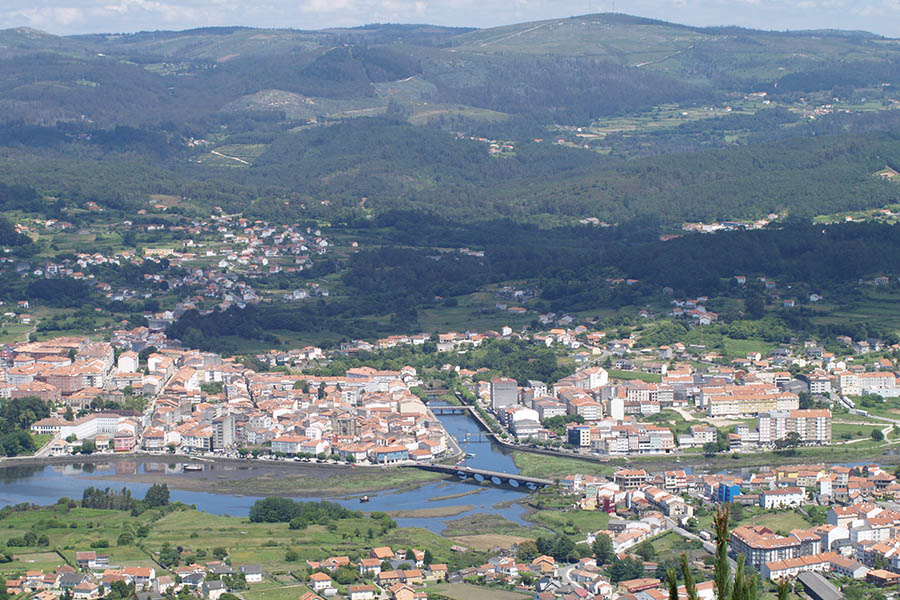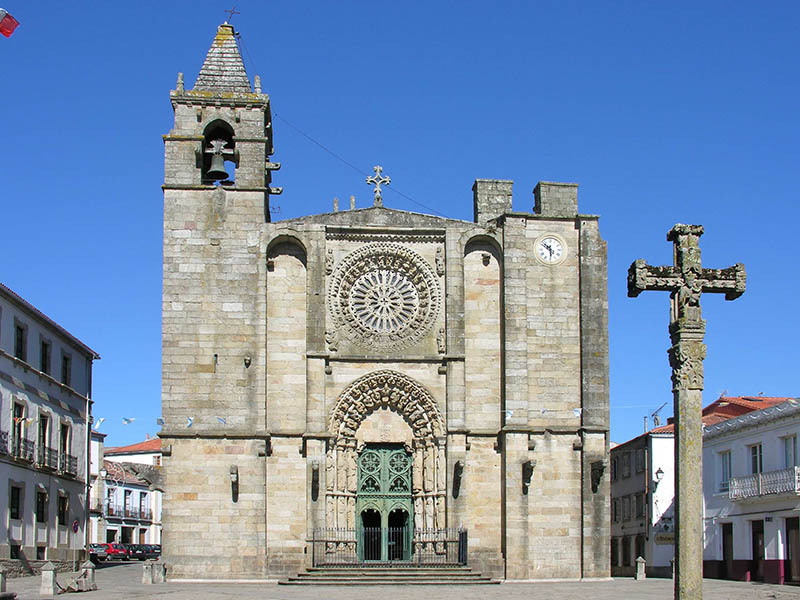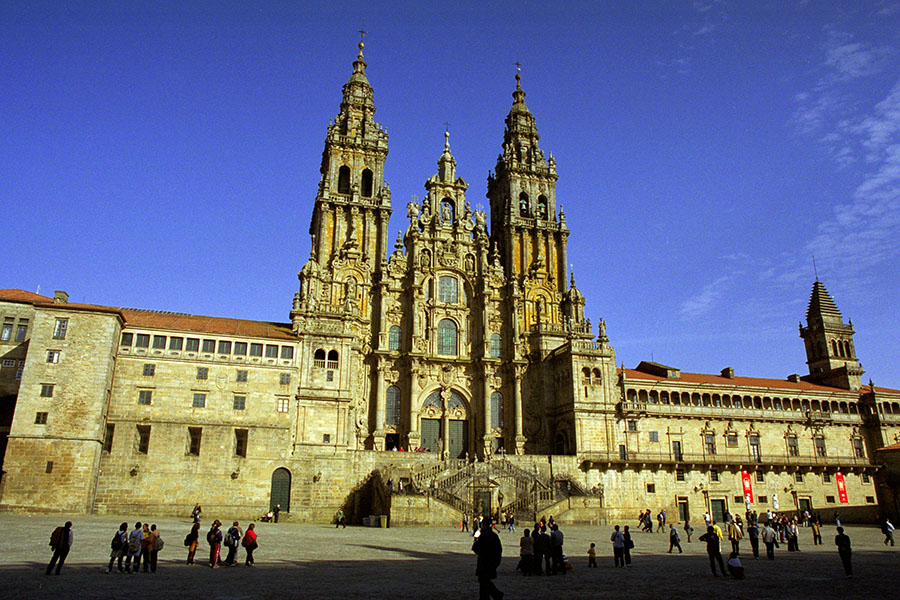The port of Santiago de Compostela. Noia was founded next to the port located at the mouth of the Tambre river. During the Middle Ages, its proximity to Compostela made it one of the most important towns in Galicia. Noia was continually harassed by pirates and for that reason it was surrounded by a wall, which even deterred the famous pirate Drake from attacking.
On the occasion of the discovery of America, some natives went on an adventure. Among them, Antón Varela, who would accompanied Magellan as a cabin boy in his first round the world trip. Or Basilio Vilariño, who lost his life in the hands of the native Americans.
In the contemporary age, Catalan businessmen settled fish salting factories in Galicia, especially sardines. The market for the skins tanning, necessary for shoemakers, which in Noia have a great popularity, flourished considerably.
There is a lot to see in the historic center of Noia. Declared Assets of cultural interest in 1985, it is one of the main attractions of the town. From any point, you can check its compact form.
It has a tight group of houses at the foot of the Church of San Martiño (San Martín) towards the sea. The perspective when doing tourism in Noia could compared to a small Galician Florence: roofs of red tiles, chimneys, towers and squares that give an effect of medieval intimacy. The entire historical ensemble is dominated by the presence of this religious building.
CHURCH OF SAN MARTÍN
Built in 1434 by Bishop Lope de Mendoza.
The facade is divided into three vertical bodies. In the extremes you can see uncompleted towers and in the center a magnificent rose window. The door has the shields of Castile and Leon and the weapons of the bishop.
In the three archivolts, the interior stands out, with Christ surrounded by twelve musicians. On the sides, in two differentiated bodies, the figures of the twelve apostles.
Inside, there is a shed with five sections separated by pointed arches. The rib vault of the main chapel and the altar is very noticeable, illuminated by a rose window smaller than the one that presides over the facade.
PAZO DA PENA DE OURO
In Obre, it is located this modern building of the early twentieth century of Compostela’s neo-Baroque style. It highlights the fact that in its construction various archaeological elements were used as a result of the plunder: its Romanesque cloister was moved in 1920 from the Toxosoutos monastery, in Lousame, and now is used as the central courtyard of the pazo; on the façade, two square-base towers, half-point arches supported by pairs of columns on square pedestal, balconies, balustrades and pinnacles or balls. There are also numerous shields from different places, both on the walls and in the garden.
CASA DA XOUBA, CASA DA ROSA, PAZO DO FORNO DO RATO
Gothic houses of French inspiration, from the 14th century, an architecture resulting from being headquarters of the archbishop Berenguel de Landoira until he could take office in the Miter of Compostela. You can see all these buildings just taking a walk through the historic center of Noia, as they are easy to find.
CHURCH OF SANTA MARÍA A NOVA
Declared a National Historic-Artistic Monument since 1973. It is located in a cemetery that, according to one of the numerous known legends in Noia, this church was built with soil brought from the Holy Land -Palestina- in galleons. It was built on top of existing building from the 12th century and was consecrated in 1327 by Archbishop Berenguel de Landoira.
Its facade shows a spectacular rose window, which is advisable to observe from the inside at different times of the day, for the play of the lights. The chapel is plateresque and the altar, in baroque style. In its exterior, the polychrome tympanum of the main door stands out, with the Adoration of the Wizards, as well as the figure of the mentioned archbishop Berenguel de Landoira kneeling, to the left of the Virgin. What is most striking is the huge deposit of guild gravestones. At least 200 of these tombstones flank the walls of the church, being the oldest those that represent trades of medieval guilds. Tombstones distinguish these by the objects engraved on them (from stonecutters to blacksmiths, through sailors with a characteristic anchor or nobles, represented by anthropoid figures). In addition to the many tombstones, elements, such as the canopy called Cristo do Humilladoiro, also stand out in the cemetery, consisting of four columns with a stone pyramidshaped roof that covers a 16th-century cross. It is convenient to observe the friezes of this curious canopy, in which the phases of the moon and an injured animal fleeing from a hunter and dogs are sculpted in stone.
HOSPITAL DE ADENTRO
Noia used to have three hospitals in the Middle Ages, two of them for pilgrims. The only building that is preserved is the Hospital de Adentro, also called Casa da Gramática. It now houses the Office of Rehabilitation of the Historic District. The door of the facade stands out, in which there are a pointed arch and the shield of the Archbishop of Compostela, Rodrigo de Luna.
NATURAL ENVIROMENT
Everything you need to see in Noia, beautiful and historic, can take up an entire day. Next day you can visit two magnificent natural parks nearby. If you take the local road AC550 by the coast heading to the south, you will reach the park of the Dunes of Corrubedo and the Carregal and Vixán lagoons. Then you can return crossing the local villages by the country road.
Another possibility is to go along the coast to the north, visiting the mountain of the Pindo, where is the magnificent view of the Ézaro, that is the only river in Europe that flows in the sea producing a waterfall. And you can also have a nice panoramic view of the mountain of Louro and the lagoon.
Best if you carry binoculars in order to admire the scenery and see the birds.
The Ría de Muros and Noia are not a popular holiday resort, so the beaches in spite of their beauty are not very well-known to tourism, although they are very natural and really worth to visit, quite and relaxing. Luckily, the construction “boom”, in this part of Galicia, did not have very much effect on it, since that not big changes were made; so the landscape are remained the same.
Apart from this, the visitor will get surprised for the kindness and the warmth of the local people and their culture, living on fishing and farming.
It should be noticed the large number of fabulous beaches in the surroundings, such as:
TESTAL BEACH
This fine white sand beach is in Taramancos, Boa, it is the longest of the beaches of Noia, within a kilometer and a half including the fish market. With a cafeteria and another amenities, Canoeing Club, and a large parking. Calm waters, it is one of the most crowded in Noia.
BOA GRANDE BEACH
With a length of 450 meters, it has a medium grade sand. Small parking. It has walkways for boardwalk. It is very suitable for water sports. It is also the most visited.
TARAMANCOS BEACH
It is in the area of Boa, but it is next to the beach of Testal, it has rocks which separate the beach into small coves of medium grade sand.
OTHER NEARBY BEACHES
- Louro beach.
- Area Maior beach.
- San Francisco beach.
- Río Sieira beach.
- Coira in Portosín.
- Queiruga in Porto do Son.
- Aguieira in Porto do Son.
- Area Longa Beach (Castro de Baroña) in Porto do Son.
- Broña in Outes.
SAN MARCOS FAIR
April the 25th and more celebrity days.
Programme: the great day takes place in San Lázaro, during the daytime there is a cattle market, jumping competitions, training horses and a show. There is a traditional market with all the accessories for cattle and farming products. Next to this there is a stand for the exhibition of agricultural machinery that summons a greater number of people every year. During the afternoon there are horse races in Testal beach. In addition to this, there are parades, Galician folk music, dances and concerts, fireworks, children’s and adults’ amenities, finishing at evening with the music bands in the Alameda.
SAN BARTOLOMÉ
Dates: from August the 20th to 26th.
During local celebration of San Roque on the 26th, there is a traditional procession to commemorate this day. Organized by the Town Hall, the origin of this celebration is based by a petition to the saint for saving the village from the sickness of the plague in the Middle Ages, and also, at the beginning of the 20th century for keeping safe from the flu. This festivity is celebrated during the evening with traditional fireworks and music bands.
ROMERÍA DE SAN LÁZARO
It is commerated on Sunday before the festivity of the Virgen de los Dolores.
It takes place in San Lázaro, in the southern area of Noia, reaching through the bridge across the Traba River. In this place was founded a hospital, in honour to San Lázaro, in order to treat the lepers. At the moment a chapel, built in 1768, still stands in good conservation and opens the day of the celebration. The faithful who come to venerate the saint carry a stamp and a branch of myrtle to pass it through the image of the Saint. Mass services are celebrated throughout the day in the area next to the chapel.
MEDIEVAL FESTIVAL
This festival has been celebrated during the second weekend of July, ever since 1998.
The initial idea was to promote the history and cultural heritage from the Middle Ages, as well as making recognition of local and Galician artistic handcrafts and cultural knowledge through the time.
The fair goes back in time recreating a medieval market across the streets, squares and buildings of the historic district, from 11am to midnight, from Friday to Sunday. People are dressing up with costumes of that period and resembling that time as close as possible, so you come across with entertainers like jugglers, jesters, knights, princes and princesses, street theatre, horse games, etc. Everything to have an enjoyable day.
World Heritage since 1985. Santiago de Compostela has been attracting visitors and pilgrims from all over the world for centuries. It is the most cosmopolitan city in Galicia but it is taken naturally, so from the first moment you feel that you are part of it. Here you have everything!
In the historic center, the Cathedral and the Portico de la Gloria. Emblematic squares such as Obradoiro, A Quintana and O Toural. Dozens of churches, convents and palaces. Romanesque, Gothic and Baroque.
And also shops, bars, restaurants and a beautiful market “Mercado de Abastos”, full of fresh produts. In addition, in the center, the Alameda with its camellia trees and the Paseo de la Herradura, with a great view of the Cathedral. And on the banks of the Sar river, the Colexiata de Santa María and its impossible inclined columns. Santiago is great, and it makes you feel that way.
The visitor of Santiago should not miss the opportunity to climb the decks of the Cathedral. The visit to the roofs of the temple was already recommended in the Calixtinus Codex to appreciate its splendid beauty. What we can add is that from here you can see a large part of the historical complex and the new part of the city, as well as the surroundings of Santiago, from Monte Pedroso to O Gozo, becoming an exceptional viewpoint. From the top of the Cathedral, you can get the best view of this mystical city. On the decks we can see the “Cruz dos Farrapos”, under which the medieval pilgrims burned their old clothes used on the way, in a kind of purifying ritual.
The most important thing is to simply relax, walk the streets, taste the local food and let yourself carry away.
Galicia’s cuisine is famous for its quality and variety.
To introduce yourself to culinary delights of Galicia, sample a range of fresh local seafood from our esturaries, such as Octopus, Squid, Mussels, Oysters, Crab, etc, just to mention a few of mouth-watering of them. The scallop is of particular importance to the Galician community as an emblem of the St James Way pilgrimage which concludes at the majestic Galician cathedral, Santiago de Compostela. You can find a wide variety in the menus of the restaurants, emphasizing Octopus «á feira».
The menu can be completed with very good meats, broths and legumes, varied “empanadas” and an excellent quality bread. To accompany the meal, great Galician wines of any of qualified denomination of origin are offered. The “orujo” (local liqueur) is very famous, as well as its derived coffee and herbal liqueurs. For the dessert, “tarta de Santiago” (almond cake), the “filloas” (pancakes) and the “tetilla” cheese with the denomiation of origin “Arzúa-Ulloa”, and the artisan chocolates “Piedras de Santiago”.
If you want to taste the Galician gastronomy in Santiago, there is a very varied offer throughout the city, but it stands out, for the number of places with options for all budgets, the area located near the Cathedral, especially in the streets Franco and Raiña, where almost all doors belong to a restaurant.
Other good options appear in the Rúa da Troia and nearby. In the area of San Roque and Praza das Penas there are several places with very good menus. On the other hand, San Clemente and Carretas Street have famous restaurants.





